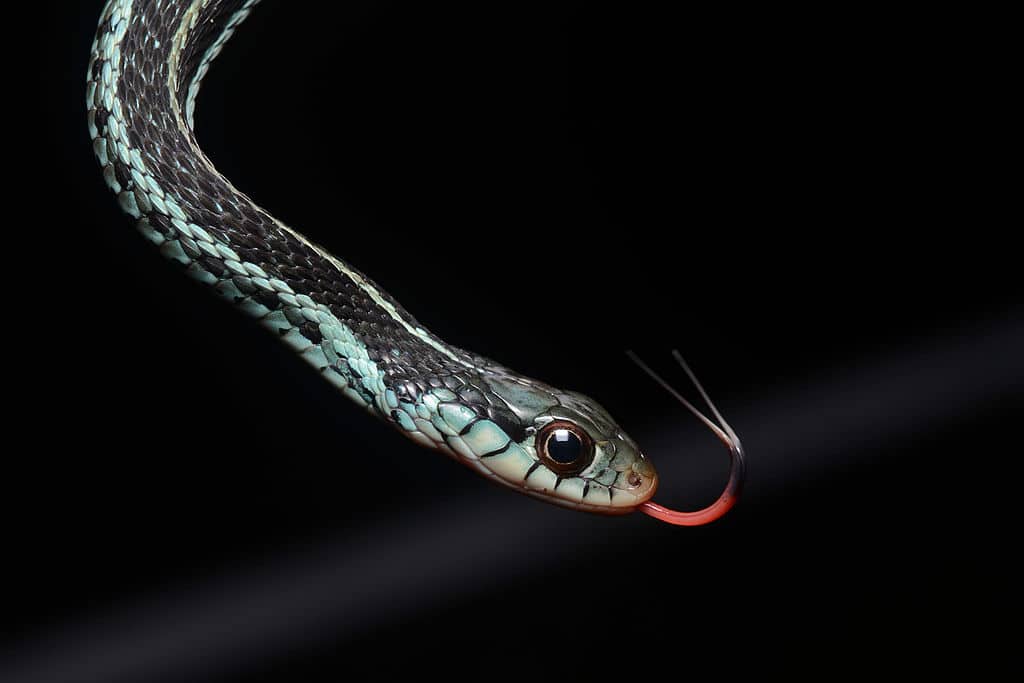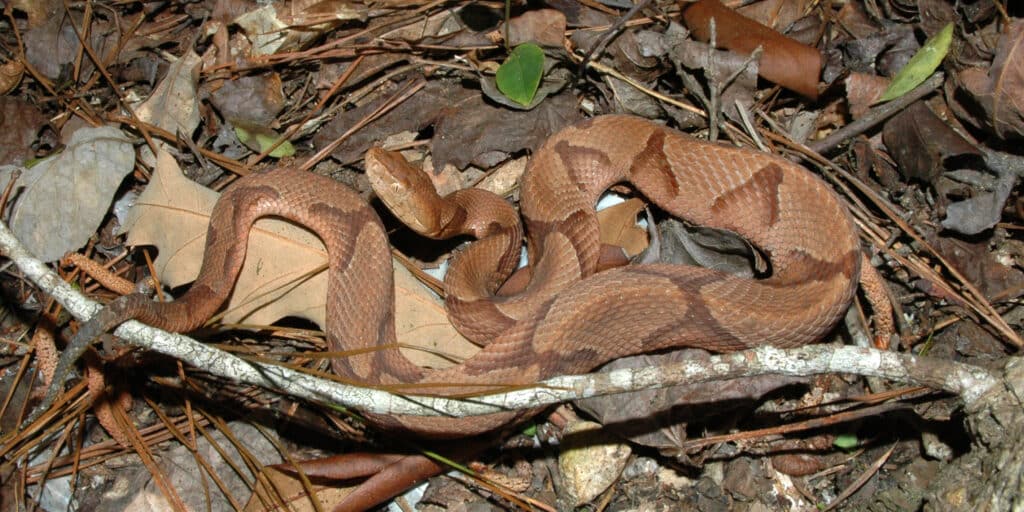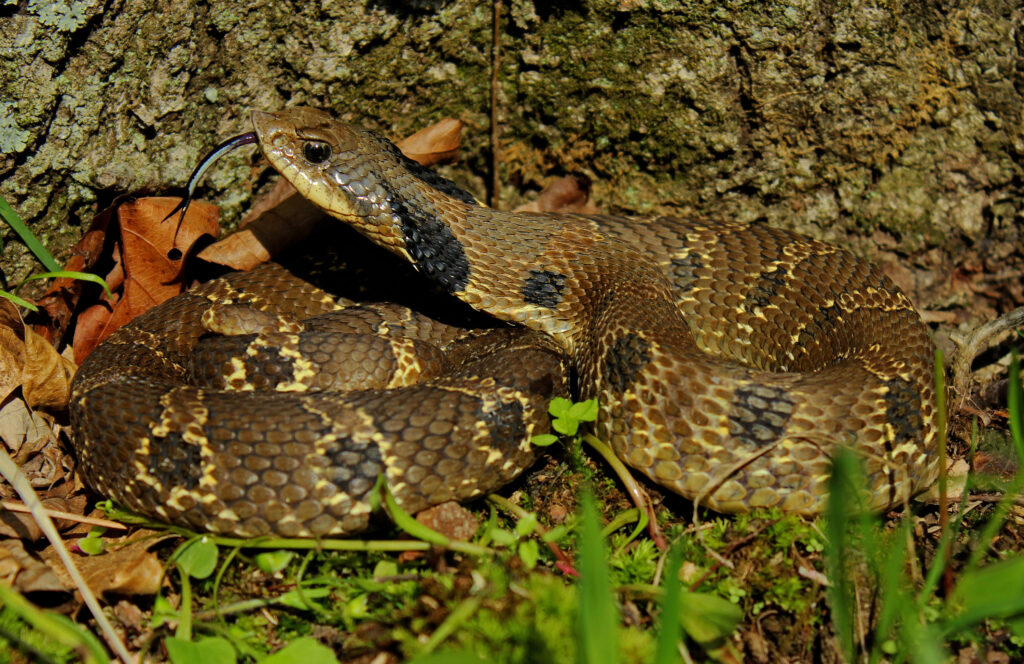What if you encounter a snake?
Suppose you encounter a snake. Even venomous ones usually don’t strike unless provoked or startled, so just slowly back away. Fortunately, a snake bite rarely kills: out of about 7,000–8,000 bites a year, there are about ten deaths. Rattlesnakes are responsible for the majority of snake bites in the United States. Snakes are shy, so if you live in an area with venomous ones, remove their hiding places by trimming up hedges and brushy areas near your foundation and play areas. Nonvenomous snakes can deliver a bite that might cause pain and swelling but are otherwise harmless to humans.
Saving LaRue Road’s snakes
The tiny Western Ribbon Snake shown below is one of the numerous species of snakes, frogs, toads, and turtles that must cross a dangerous road in Shawnee National Forest during their migration seasonal migrations. So, from September to mid-October and again from mid-March to mid-May every year, authorities close the road to auto traffic. The road stretches between dry limestone bluffs the snakes use in winter and LaRue Swamp, where they spend the summer. Each year, such vast numbers of animals (about 25 percent of the snakes alone) were being run over that, in 1972, the U.S. Forest Service began the biannual closing. Thousands of people come to watch the snakes.
Why are snakes so creepy?
Snakes seem creepy because most animals have something cute—or even cuddly— about them, especially as babies. A baby snake, however, is just a smaller version of the adult: scaly, hairless, and lacking eyelids, giving them an unsettling stare. And they’re legless—not even stubby legs like those of butterfly caterpillars (although some pythons and boas, perhaps others, have little bud-like remnants of back legs.) Evidence suggests snakes descended from lizards.

A baby California King Snake, Lampropeltis getula californiae, can grow up to 78 inches (2 m) long. (© David A. Litman / Shutterstock)
What’s with the scary tongue-flicking?
Snakes flick their tongue a lot, making them look threatening, but they have a practical reason: to taste their environment. The Blue-striped Snake shown below is sampling whatever chemical molecules were in the air, including those of the human holding the camera! You can read more about a snake’s tongue on this page.
Snake hibernation
It’s commonly thought that snakes hibernate in winter, but their “hibernation” is not quite that. They do find places out of the weather to spend the winter. And they sleep, but in a state called brumation, wherein metabolic activity is not as reduced as in true hibernation. Although snakes can go for months without food, they can’t go without water and often wake up to drink. Falling temperatures and shorter days trigger brumation.

A Timber Rattlesnake, Crotalus horridus, is looking out of its hibernaculum. (Richard Bonnett / Flickr; CC BY 2.0)
What’s in a name? Gopher Snake, Bullsnake, Blow Snake, Henry Snake . . .
Pacific gopher snake, Bullsnake, Blow Snake, Henry Snake, Coast Gopher Snake, Churchill’s Bullsnake, Oregon Bullsnake, Western Bullsnake, Western Gopher Snake, Pacific Pine Snake, Western Pine Snake, Sonoran Gopher Snake, Great Basin Gopher Snake, and Yellow Gopher Snake. These are all names used for the Gopher Snake, Pituophis catenifer, and its subspecies.
Gopher snakes are common and widespread, with a range that extends from the Atlantic coast to the Pacific and from southern Canada to Baja California, Mexico. Their habitat includes deserts, prairies, brushlands, woodlands, coniferous forests, and farmlands. Yellowish or pale brown, with a series of large, dark brown or black blotches and smaller, dark spots on the sides, they grow 36 to 84 inches (0.9–2.1 m) long.
Their defense posture is to puff up and curl themselves into the classic strike pose of a rattlesnake and vibrate their tail, although they have no rattles. This mimicry can cause them to be misidentified as rattlesnakes, although they’re harmless to humans. Instead of striking with an open mouth, they often bump with a closed mouth to warn predators.
Gopher snakes often make their home in abandoned gopher burrows. Their prey includes small rodents, rabbits, lizards, and birds, which they suffocate by squeezing.
Copperhead Snake, Agkistrodon contortrix
There are five subspecies of the Copperhead Snake, which differ primarily by geographic range. All have dark brown, hourglass-shaped markings overlaid on a light reddish brown or brown-gray background. They have a heavy body that typically grows 20 to 37 inches (50–95 cm) long. They’re spread out across the lower Midwest, South, Southeast, and Northeast in woodlands and rocky, brushy areas, and sometimes swamps.
Beneficial predators, they help to keep small rodents under control. But keep away—they’re venomous. Although not aggressive, their markings camouflage them well, and they’ll strike if cornered or stepped on by an unsuspecting person. Sometimes, their first bite will be a warning that contains no venom at all. They primarily feed on mice but also other animals, such as small birds, lizards, small snakes, amphibians, and insects.
Hognose snake, genus Heterodon
Hognose Snake is the name for numerous unrelated species with upturned snouts, classified into two different snake families. Five of them, belonging to the family Colubridae, genus Heterodon, inhabit the U.S.
One of the most notable features of hognose snakes is their upturned snout, which resembles a pig’s snout. Their appearance is highly variable and can range from yellow, tan, or brown to gray or black, often with blotches, speckles, or bands. Their size varies from 14 to 46 inches (36–115 cm), depending on the species.
Hognose snakes are distributed across the U.S. and found in various habitats, including grasslands, woodlands, scrublands, prairies, sandy areas, agricultural areas, and suburban landscapes. They often prefer loose, sandy soil that’s conducive to burrowing. Beneficial predators, they feed on rodents, lizards, toads, and insects. They often display distinctive defensive behaviors. These may include flattening their body, hissing, and even playing dead by rolling onto their back with their mouth open and tongue hanging out. This can deter a predator that prefers “live” prey.
All about snakes
Common questions about snakes
In your yard: Big Brown Bat
Expect amazing results with a backyard wildlife habitat










